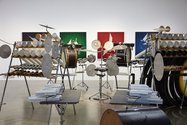John Hurrell – 25 May, 2018
From Scratch make catchy and hypnotic music—with rhythm its key element—with similarities to say, the driving rockier numbers of the German group Can, or the English group Soft Machine, even though its origins (when formed in the mid-seventies) are from avant-garde classical music, detectable with its affinities to minimalists Glass, Riley and Reich in its use of repetition. What is interesting is that the characteristic deep bass (vibrating) sound from the thumped plastic pipes sounds strangely ‘airy' or ‘breathy'—like a wind instrument. It's physical: very bodily, earthy, and penetrating. Though complex, it's drum music for intellectuals to dance to.
Titirangi
From Scratch
546 Moons
Curated by Andrew Clifford
3 March - 27 May 2018.
A survey show taking up two floors, 546 Moons allows us to see and hear the experimental rock group From Scratch, to celebrate the work of Phil Dadson, Don McGlashan, Wayne Laird, Geoff Chapple, James McCarthy and other musical collaborators in this legendary three (occasionally four) piece band—with its carefully devised, extremely unusual, mostly percussive instruments.
The word ‘rock’ is so elastic in its musical application that it is almost meaningless, but these players know—as Duke Ellington once put it—that “it don’t mean a thing if it ain’t got that swing.” It is catchy and hypnotic music—with rhythm its key element—with similarities to say, the driving rockier numbers of the German group Can, or the English group Soft Machine, even though its origins (when formed in the mid-seventies) are from avant-garde classical music, detectable with its affinities to minimalists Glass, Riley and Reich in its use of repetition. What is interesting is that the characteristic deep bass (vibrating) sound from the thumped plastic pipes sounds strangely ‘airy’ or ‘breathy’—like a wind instrument. It’s physical: very bodily, earthy, and penetrating. Though complex, it’s drum music for intellectuals to dance to.
Not only is From Scratch a vibrant band, but it can also be seen as visual art: live performance involving movement, drawing, theory and action as a form of onstage (or gallery, moving or static) sculpture. The position of every player and instrument is schematically worked out carefully in advance, with performers sometimes shifting ‘stations’ during performances.
On Te Uru’s ground floor, in Gallery One, we have aural and photographic documentation of various tours, their promotional posters, video recordings, and many examples of their invented instruments. Plus some of Dadson’s geometric graphite drawings on black paper that he exhibited in Artspace in the eighties.
On Te Uru’s middle floor in Galleries Two and Three, there are more instruments, videos of performances, and more documentation-including compositional scores-that are not to be touched. In Gallery Two though, visitors are encouraged to experiment with the strange Heath Robinsonish devices (mostly made by Dadson, in the tradition of Harry Partch), to try making sounds by hitting, plucking, shaking, pinging, strumming, rocking, tapping, rattling, stroking, blowing, rubbing and so on. This reflects a non-precious view of creativity, that anybody can be an artist or musician; they just need to have their potential industriousness kick-started by being shown the wonders of aural texture, and the concentrated intensity of each participatory listening moment.
There is a theoretical component to From Scratch, revolving around the band’s interest in the philosophy of Rewi Alley, the New Zealand-born communist who (as a poet and social reformer) lived in China, and was a colleague of Mao Zedong and Che Guevara. I might be mistaken, but the connections between theory and praxis seem to have been downplayed here, which is surprising because I think younger generations would find it immensely interesting. The re-publication tomorrow of the Splash 5 magazine might shed more light on this aspect.
John Hurrell
Recent Comments
John Hurrell
Using Corban's Shed 2 in Henderson, From Scratch's PAX/PACIFICA gig last night--the last of a mostly South Island tour--was full ...















 Advertising in this column
Advertising in this column Two Rooms presents a program of residencies and projects
Two Rooms presents a program of residencies and projects



This Discussion has 1 comment.
Comment
John Hurrell, 9:21 a.m. 6 October, 2020 #
Using Corban's Shed 2 in Henderson, From Scratch's PAX/PACIFICA gig last night--the last of a mostly South Island tour--was full of surprises, presenting two works that emphasised delicacy, improvisation and co-ordinated structure over bassy hypnotic driving rhythms. The expected driving thumped PVC pipes did not dominate, giving way to intricate aural textures normally associated with Dadson's solo shows. Now, with a new From Scratch iteration--Adrian Croucher, Shane Currey, Darryn Harkness and Phil Dadson--the performance seems more complex and varied, using movement and immersive space (the audience in a huge circle) and with a surprising number of homemade wind instruments not associated with this normally percussive band.
With its spasmodic explosive outbursts about nuclear contamination and climate change, it was (as usual) incredibly current; incorporating a wonderful new intimate (but super-layered) aural complexity.
Participate
Register to Participate.
Sign in
Sign in to an existing account.